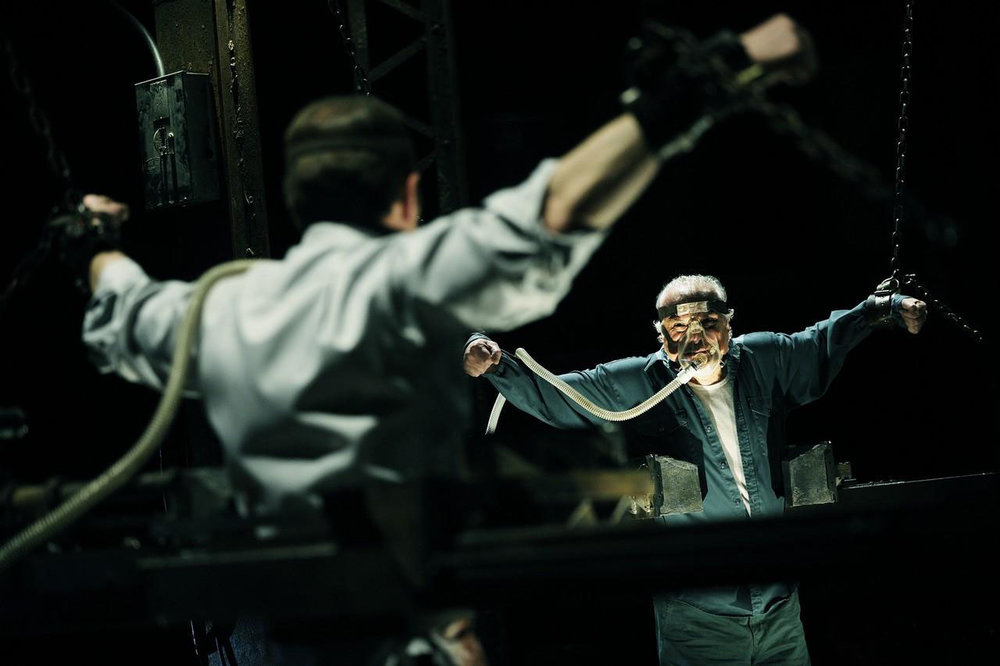
Healing the Sixth
I really didn’t like Saw V. The original Jigsaw Killer, John Kramer (Tobin Bell), had been dead since the third film, replaced by an un-charismatic thug cop named Hoffman (Costas Mandylor). A new batch of seemingly unrelated people were locked in a maze of elaborate traps, forced to work together to survive; neither the games nor the characters were as memorable as those from Saw II, where this plot-line was first injected into the series. Then there was the ending, in which the one remaining interesting character—a good cop named Peter Strahm (Scott Patterson)—was brutally killed off in a way that seemed unusually cruel, even for the franchise that unfairly birthed the term “torture porn.” The movie left me feeling depressed, angry, and sure that the Saw movies had finally run their course.
I went into Saw VI with marginal enthusiasm. The TV spots were customarily vague; the only thing I knew for sure was that Kramer would return, and a deadly merry-go-round was somehow part of the story. I felt sort of relieved, though, because I told myself that if (when) the movie sucked, I would be unburdened of my need to see any more sequels in the theatre—possibly ignoring them altogether. Fortunately for both my mood and for Lionsgate Films, I was pretty blown away by Saw VI.
“’Blown away?’” You might ask. “Really?”
To which I offer a qualified “yes.” While the movie does have its share of problems, director Kevin Greutert and screenwriters Patrick Melton and Marcus Dunstan do two new things with this film: they tone down the gore and give the film a message. It’s not the same “you can’t appreciate life until you’ve faced death” message of the other movies—though it’s certainly in there. No, Saw VI is about the need for universal health care, and insurance companies that murder American citizens every day by denying them coverage.
I’m not kidding. Soak it in.
The set-up, which recalls Saw III, sees an insurance company head named William (Peter Outerbridge) navigating an abandoned zoo that has been rigged with Hoffman/Jigsaw’s deadly games. They include a race through red-hot steam tunnels, a rib-smashing breathe-holding exercise, and the aforementioned merry-go-round, in which people are shot-gunned to death when the wheel stops; all of the participants in these games are associates of William’s, from his secretary and copy boy to his chief legal counsel and the pack of power-hungry associates whose job it is to look for coverage loopholes in policies. To varying degrees, William must determine who lives and who dies.
Running parallel to the main story is detective Hoffman’s struggle to keep his alter ego a secret while carrying out the games designed by the late John Kramer. We’re re-introduced to a presumed-dead character, as well as to Kramer’s ex-wife, Jill Tuck (Betsy Russell), and they both intensify Hoffman’s paranoia in different ways. I was not as engaged in these sub-plots, which were heavy on details that either referenced minutiae in the previous films or—I suspect—set up events for the later ones. They do serve a vital purpose in giving Hoffman an arc, however, taking him from somber lackey to impulsive brute, a marked contrast to his sophisticated, deep-thinking predecessor. Until this chapter, I’d assumed Costas Mandylor was either a bad actor or wholly disinterested in the role; in Saw VI his character is forced from his cold shell and shown to be relentless and cunning.
Speaking of cunning, I thought it was pretty ballsy of the filmmakers to make the sixth film in a popular horror franchise into a soapbox. Sure enough, there’s a flashback in which Kramer confronts William about a denied claim for his cancer treatment; he circles the executive’s office, spouting off about how the government and the doctors are not the problem, that it’s the insurance companies who are the real societal parasites. I almost couldn’t believe what I was seeing. Never mind that I agree with the film’s point of view; I just loved that fact that Lionsgate has found a way to make the news entertaining (and subversive: in one scene, a tearful policy reader yells to William, “I’m on your side!” Which is a variation on Nationwide Insurance’s slogan).
As I said before, the movie has problems. The director spends a little too much time constructing arguments and visual metaphors that he forgets how to make horror movies scary. Many of the gags and jumps are telegraphed way too early and way too sloppily (a security guard who’s mistaken for an assailant; a series of six envelopes containing the game’s participants, one of which turns up missing until a “big reveal” at the climax). But what Kevin Greutert lacks in tension instincts, he makes up for in misdirection, particularly as it applies to the identity of two key characters; it’s the kind of surprise one should be used to in these movies, but damn it if I wasn’t caught off-guard.
Saw VI is not for everyone, but I think everyone should see it; at least the insurance executive portions. If Lionsgate could have an edited version of the movie shown on the House and Senate floors, we would soon have a) universal health care and b) higher ratings for C-SPAN.
Seriously, though, I cannot wait for Saw VII. Even if they leave the political messages out of it, I at least have hope that someone is minding the store, creatively. The fact that I can be surprised and entertained by the sixth installment of a series I’d almost written off as dead is enough to earn these pictures some good will for another year or two. There are more ideas and emotions at play here than I've seen since Saw III. And if later on the ideas start to peter out again, I’d love to see Jigsaw tackle global warming or the declining U.S. dollar.

